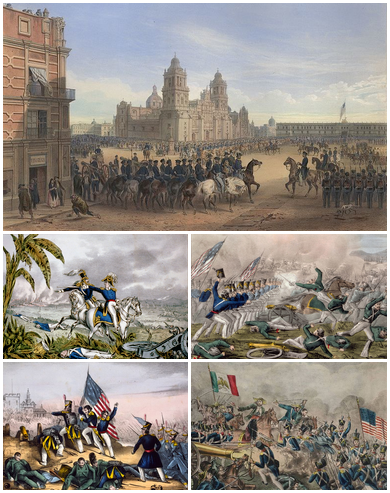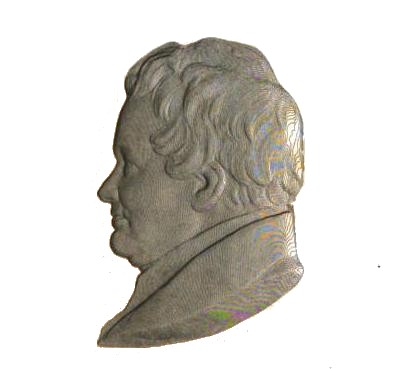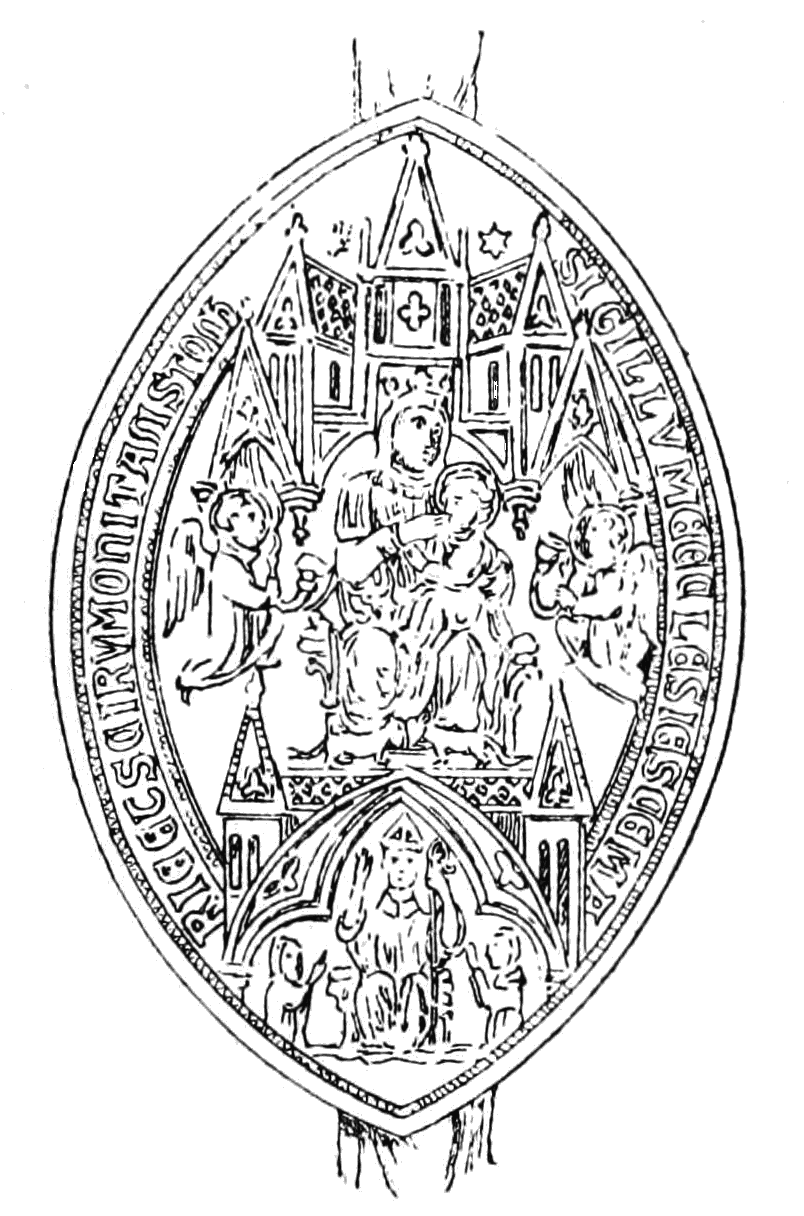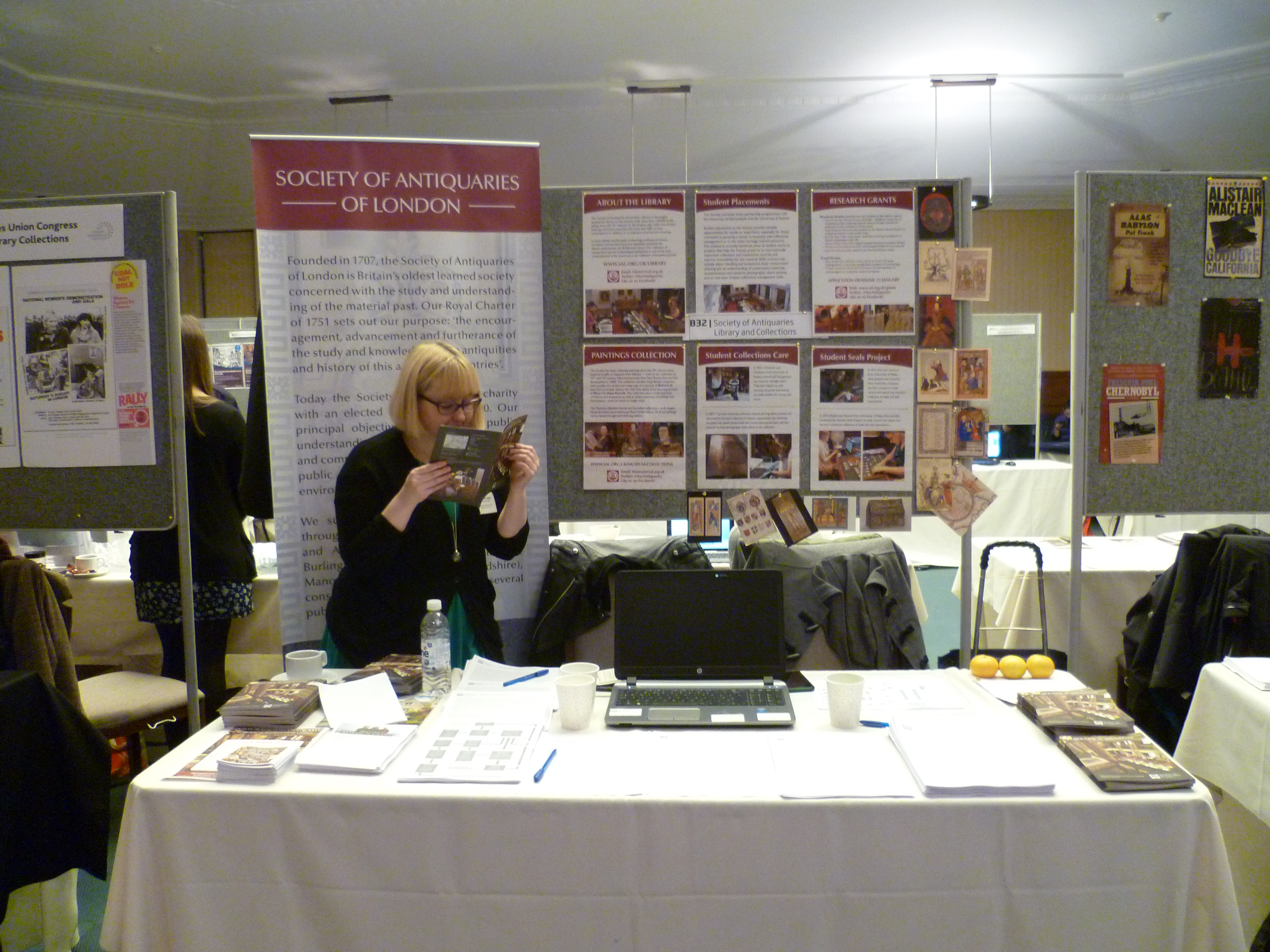|
Alfred John Kempe
Alfred John Kempe (1784 – 21 August 1846) was an English antiquary. Life Kempe was born in London, and baptised at the church of St Mary, Newington on 16 July 1784. He was the only son of John Kempe, bullion-porter in the Royal Mint, and his wife Anne, youngest daughter of James Arrow of Westminster, who died in 1835. The novelist Anna Eliza Bray was his sister. He was educated by two French refugees, but was not trained for any specific employment. For about five years Kempe held a commission in the Tower Hamlets militia, but resigned his post in 1811, and lived for a time at Chepstow and Swansea. In the summer of 1813 he moved to the neighbourhood of Holwood Hill in the parish of Keston in Kent. Charles Alfred Stothard, who married his sister, interested him in antiquities and they spent much time exploring the district. Later on Kempe pursued investigations into the ancient remains at Keston with Thomas Crofton Croker. Following Stothard's death in 1821, Kempe helped his ... [...More Info...] [...Related Items...] OR: [Wikipedia] [Google] [Baidu] |
John Barak Swaine
John Swaine (26 June 1775 – 25 November 1860), was an England, English wikt:draughtsman, draughtsman and engraver. Life and work Swaine was born at Stanwell, Middlesex, on 26 June 1775, the son of John and Margaret Swaine, and became a pupil first of Jacob Schnebbelie and afterwards of Barak Longmate. He is best known for his excellent facsimile copies of old prints, of which the most noteworthy are the famous portrait of Shakespeare by Martin Droeshout, William Faithorne's portrait of Thomas Stanley (author), Thomas Stanley, David Loggan's frontispiece to the Book of Common Prayer, and the plates to William Young Ottley, William Ottley's ‘History of Engraving,’ (1816), and Samuel Weller Singer, Singer's ‘History of Playing Cards,’ 1816. He also engraved many illustrations for various scientific, topographical, and antiquarian works, including the whole series of plates in William Marsden (orientalist), William Marsden's 'Oriental Coins,’ (1823–5), and many subject ... [...More Info...] [...Related Items...] OR: [Wikipedia] [Google] [Baidu] |
Kent
Kent is a Ceremonial counties of England, ceremonial county in South East England. It is bordered by Essex across the Thames Estuary to the north, the Strait of Dover to the south-east, East Sussex to the south-west, Surrey to the west, and Greater London to the north-west. The county town is Maidstone. The county has an area of and had population of 1,875,893 in 2022, making it the Ceremonial counties of England#Lieutenancy areas since 1997, fifth most populous county in England. The north of the county contains a conurbation which includes the towns of Chatham, Kent, Chatham, Gillingham, Kent, Gillingham, and Rochester, Kent, Rochester. Other large towns are Maidstone and Ashford, Kent, Ashford, and the City of Canterbury, borough of Canterbury holds City status in the United Kingdom, city status. For local government purposes Kent consists of a non-metropolitan county, with twelve districts, and the unitary authority area of Medway. The county historically included south-ea ... [...More Info...] [...Related Items...] OR: [Wikipedia] [Google] [Baidu] |
1846 Deaths
Events January–March * January 5 – The United States House of Representatives votes to stop sharing the Oregon Country with the United Kingdom of Great Britain and Ireland, United Kingdom. * January 13 – The Milan–Venice railway's bridge, over the Venetian Lagoon between Mestre and Venice in Italy, opens, the world's longest since 1151. * January 23 – Ahmad I ibn Mustafa, Bey of Tunis, declares the legal abolition of slavery in Tunisia. * February 4 – Led by Brigham Young, many Mormons in the U.S. begin their migration west from Nauvoo, Illinois, to the Great Salt Lake in what becomes Utah. * February 10 – First Anglo-Sikh war: Battle of Sobraon – British forces in India defeat the Sikhs. * February 18 – The Galician Peasant Uprising of 1846 begins in Austria. * February 19 – Texas annexation: United States president James K. Polk's annexation of the Republic of Texas is finalized by Texas president Anson Jones in a formal ceremony of transfer of sover ... [...More Info...] [...Related Items...] OR: [Wikipedia] [Google] [Baidu] |
1780s Births
Year 178 ( CLXXVIII) was a common year starting on Wednesday of the Julian calendar. At the time, it was known as the Year of the Consulship of Scipio and Rufus (or, less frequently, year 931 ''Ab urbe condita''). The denomination 178 for this year has been used since the early medieval period, when the Anno Domini calendar era became the prevalent method in Europe for naming years. Events By place Roman Empire * Bruttia Crispina marries Commodus, and receives the title of '' Augusta''. * Emperor Marcus Aurelius and his son Commodus arrive at Carnuntum in Pannonia, and travel to the Danube to fight against the Marcomanni. Asia * Last (7th) year of ''Xiping'' era and start of ''Guanghe'' era of the Chinese Han dynasty. * In India, the decline of the Kushan Empire begins. The Sassanides take over Central Asia. Religion * The Montanist heresy is condemned for the first time. Births * Lü Meng, Chinese general (d. 220) * Peng Yang, Chinese official (d. 214) ... [...More Info...] [...Related Items...] OR: [Wikipedia] [Google] [Baidu] |
Leyton, Essex
Leyton ( ) is a town in East London, England, within the London Borough of Waltham Forest. It borders Walthamstow to the north, Leytonstone to the east, and Stratford, London, Stratford to the south, with Clapton, London, Clapton, Hackney Wick and Homerton, across the River Lea, to the west. The area includes New Spitalfields Market, Leyton Orient Football Club, as well as part of the Queen Elizabeth Olympic Park. The town consists largely of terraced houses built between 1870 and 1910, interspersed with some modern housing estates. It is north-east of Charing Cross. It was historically part of the ancient parish of Municipal Borough of Leyton, Leyton St Mary in the Becontree Hundred, Becontree hundred and part of the Historic counties of England, ancient county of Essex. The town expanded rapidly in the late 19th century, forming part of the conurbation of London and becoming a suburb, similar to much of south-west Essex. It became part of the Metropolitan Police District i ... [...More Info...] [...Related Items...] OR: [Wikipedia] [Google] [Baidu] |
John Dunkin
John Dunkin (16 May 1782 – 22 December 1846) was an English topographer. Life He was the son of John Dunkin of Bicester, Oxfordshire, by his wife, Elizabeth, widow of John Telford, and daughter of Thomas and Johanna Timms, was born at Bicester on 16 May 1782. While attending the free school of that town, he met with a severe accident, and for many years it was feared that he would remain a cripple for life. He employed the leisure thus imposed upon him chiefly by scribbling verses, but contrived at the same time to pick up some knowledge of history and archæology. After serving an apprenticeship to a printer, and living for a while in London, he established himself before 1815 as a bookseller, stationer, and printer at Bromley, Kent. Here he published his first topographical work, a compilation in part from Philipott, Hasted, and Lysons, entitled ''Outlines of the History and Antiquities of Bromley in Kent. … To which is added an investigation of the Antiquities of Holw ... [...More Info...] [...Related Items...] OR: [Wikipedia] [Google] [Baidu] |
Tavistock Abbey
Tavistock Abbey, also known as the Abbey of Mary, the mother of Jesus, Saint Mary and Saint Rumon, is a ruined Order of Saint Benedict, Benedictine abbey in Tavistock, Devon. The Abbey was surrendered in 1539 during the Dissolution of the Monasteries. Nothing remains of the abbey except the refectory, two gateways and a porch. The abbey church, dedicated to Blessed Virgin Mary, Our Lady and St Rumon, was destroyed by Denmark, Danish raiders in 997 and rebuilt under Lyfing of Winchester, Lyfing, the second abbot. The church was further rebuilt in 1285 and the greater part of the abbey between 1457 and 1458. History Foundation Older historians thought the abbey was founded in 961 by Ordgar, Ealdorman of Devon, but the modern consensus is that it was wholly the foundation of his son Ordwulf in 974; in 981 the charter of confirmation was granted by King Æthelred the Unready, Ordwulf's nephew. It was endowed with lands in Devon, Dorset and Cornwall, and became one of the richest ab ... [...More Info...] [...Related Items...] OR: [Wikipedia] [Google] [Baidu] |
Archaeologia (London)
The Society of Antiquaries of London (SAL) is a learned society of historians and archaeologists in the United Kingdom. It was founded in 1707, received its royal charter in 1751 and is a registered charity. It is based at Burlington House in Piccadilly, a building owned by the UK government. The modern membership of around 3,300 fellows mostly consists of archaeologists and historians, who can use the post-nominal letters FSA after their names. Membership Fellows (full members) of the society are elected by existing fellows and are entitled to use the post-nominal letters FSA after their names. The election procedure is selective and fellowship is regarded as recognition of significant achievement in the fields of archaeology, antiquities, history or heritage. A nomination must be made by an existing fellow and endorsed by between five and twelve other fellows. A secret ballot of the membership is then held; to be successful a candidate must receive two "yes" votes for ever ... [...More Info...] [...Related Items...] OR: [Wikipedia] [Google] [Baidu] |
Fellow Of The Society Of Antiquaries Of London
The Society of Antiquaries of London (SAL) is a learned society of historians and archaeologists in the United Kingdom. It was founded in 1707, received its royal charter in 1751 and is a Charitable organization, registered charity. It is based at Burlington House in Piccadilly, a building owned by the Government of the United Kingdom, UK government. The modern membership of around 3,300 fellows mostly consists of archaeologists and historians, who can use the post-nominal letters FSA after their names. Membership Fellows (full members) of the society are elected by existing fellows and are entitled to use the post-nominal letters FSA after their names. The election procedure is selective and fellowship is regarded as recognition of significant achievement in the fields of archaeology, antiquities, history or heritage. A nomination must be made by an existing fellow and endorsed by between five and twelve other fellows. A secret ballot of the membership is then held; to be s ... [...More Info...] [...Related Items...] OR: [Wikipedia] [Google] [Baidu] |
Fulham Road
Fulham Road is a street in London, England, which comprises the A304 and part of the A308. Overview Fulham Road ( the A219) runs from Putney Bridge as "Fulham High Street" and then eastward to Fulham Broadway, in the London Borough of Hammersmith and Fulham, through Chelsea to Brompton Road Knightsbridge which continues to the A4 in Brompton, in the Royal Borough of Kensington and Chelsea. It is designated the A304 as far as its junction with the A308 road at Gunter Grove, where the A308 then forms the eastern section of the street. Fulham Road is roughly parallel to King's Road, from Fulham Palace. There are numerous antique dealers and specialist interior furnishing shops, while designer couture outlets have begun to arrive at the eastern end. The section nearest the cinema is known as ''The Beach'', and is home to various trendy bars, pubs and clubs. The nearest underground stations are: South Kensington and Gloucester Road. Fulham Road is known for the followi ... [...More Info...] [...Related Items...] OR: [Wikipedia] [Google] [Baidu] |
Calendar (archives)
A calendar (sometimes historically spelled kalendar) is, in the context of archival science, textual scholarship, and archival publication, a descriptive list of documents. The verb ''to calendar'' means to compile or edit such a list. The word is used differently in Britain and North America with regard to the amount of detail expected: in Britain, it implies a detailed summary which may be used as a substitute for the full text; whereas in North America it implies a more basic inventory. Etymology The term "calendar" derives from a (now somewhat archaic) word meaning a list or register of any kind. Although the documents in a calendar are generally arranged in chronological order, the term has no direct relationship to a table of dates. British tradition In the British tradition, the word normally implies a full descriptive summary (often published) in which each document is the subject of a "carefully controlled, rigorously consistent précis".Harvey 2001, pp. 56–59. All sign ... [...More Info...] [...Related Items...] OR: [Wikipedia] [Google] [Baidu] |
Thomas Crofton Croker
Thomas Crofton Croker (15 January 1798 – 8 August 1854) was an Irish antiquary, best known for his ''Fairy Legends and Traditions of the South of Ireland'' (1825–1828), and who also showed considerable interest in Irish song and music. Although ''Fairy Legends'' purported to be an anthology of tales Croker had collected on his field trips, he had lost his manuscript notes and the work had to be reconstructed with the help of friends. He did not acknowledge his debt satisfactorily in the estimation of Thomas Keightley, who voiced his complaint publicly, and soon published his own rival work. The other collaborators generally allowed Croker to take credit, notably William Maginn, though after his death his kinsmen insisted Maginn had written four or more of the tales. Croker retracted ten tales in his third edition of (1834), and after his death, a fourth edition (1859) appeared which was prefaced with a memoir written by his son. William Butler Yeats, who appropriat ... [...More Info...] [...Related Items...] OR: [Wikipedia] [Google] [Baidu] |





